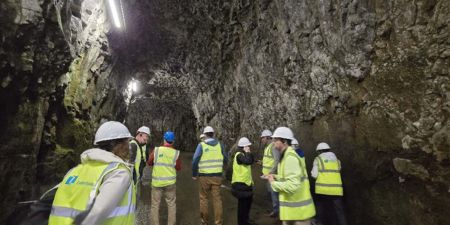
For the final day, CREATE headed to the Írafossstod Hydroelectric Power Station in the morning which offered a fascinating glimpse into the heart of Iceland’s renewable energy landscape. Nestled along the Sog River and operated by Landsvirkjun, this mid-sized hydroelectric facility exemplifies how careful planning and community engagement can harmonize energy production with environmental stewardship.
Originally constructed in 1953, the Írafossstod plant included two 15MW generating units. A third unit was added in 1963, bringing the total capacity up to 48MW. The station’s unique design and operational strategies mitigate the effects on both nature and local communities. The visual impact of the plant on the landscape was minimized with the penstocks, powerhouse, and tailrace being constructed largely inside a giant underground tunnel that was blasted from the surrounding rock. The plant operates at 70-80% capacity, thanks to Iceland’s diverse energy portfolio that includes substantial geothermal resources.
Our guide, Gummi, highlighted the historical and technical aspects of the plant. Funded partially by the United States under the Marshall Plan, the plant boasts robust engineering, with its Westinghouse and Asea turbines still running smoothly after nearly 75 years. Notably, the plant features an innovative oil/water separator system and a unique vacuum setup to remove debris that results from wear to the turbine brushes. This improves indoor air quality at the plant, while also reducing maintenance needs and extending the equipment’s operating life.
Community engagement is central to Landsvirkjun’s approach, balancing energy needs with preserving natural resources. Despite some resistance from local farmers and fishers concerned about water levels, the company strives to maintain positive relationships through transparency and proactive communication.
This visit underscored the importance of sustainable practices and continuous innovation in the energy sector. As Iceland moves towards carbon neutrality by 2025, sites like Írafossstod demonstrate the potential for renewable energy to power our future while respecting the environment and local communities.
The final stop for the CREATE international team was a visit to Friðheimar, a remarkable geothermal-powered greenhouse and Icelandic horse farm. It showcased how Iceland harnesses its unique natural resources to achieve sustainable agriculture. Located near Reykholtshver, an ancient geyser providing a steady supply of 100°C hot water, Friðheimar leverages geothermal energy to create a year-round haven for growing organic tomatoes, lettuce, and herbs.
The greenhouses are heated with Geothermal energy. This ensures that they remain warm even during Iceland’s harsh winters. Electricity is provided from hydropower. The facility uses advanced lighting systems to provide 17-20 hours of light daily, essential for plant growth during the dark Arctic winters. This innovative use of renewable energy highlights the potential for sustainable agriculture in challenging environments.
Friðheimar’s greenhouses started with just 600 square feet and have expanded to 10,000 square feet, producing an impressive 700 tons of tomatoes annually. The site’s success is also attributed to their unique approach to pollination. Bumblebees imported weekly from the Netherlands play a crucial role in pollinating the plants, maintaining the organic growing process.
The farm also integrates technology and automation to optimize operations, tracking the pollination of individual tomato plants. This illustrates how modern advancements can enhance traditional agriculture. Additionally, Friðheimar has embraced tourism, attracting 250,000 visitors annually. Guests can enjoy the farm’s produce in an on-site restaurant, which offers innovative dishes like tomato beer and freshly made tomato soup.
This visit to Friðheimar highlighted the incredible potential of renewable energy in agriculture, the importance of sustainable practices, and the integration of technology in farming. It stands as a testament to Iceland’s commitment to sustainability and innovation, making it a leader in renewable energy and sustainable agriculture.
Over the last week, the CREATE team has had the opportunity to see many valuable resources and learn about the clean energy and transportation infrastructure changing the landscape in Iceland. In the months to come, our faculty will use this experience and the knowledge gained to develop curriculum and instructional materials, and to share what they have learned with others, with the ultimate goal of creating a better energy future for the U.S. and the world as a whole.
Sign up for the CREATE Newsletter and stay updated on the latest information in Renewable Energy Education.
Copyright @ 2025 CREATE National Energy Center
This material is based upon work supported by the National Science Foundation under Grant #2201631. Any opinions, findings, and conclusions or recommendations expressed in this material are those of the author(s) and do not necessarily reflect the views of the National ScienceFoundation.